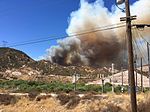Cajon Pass

Cajon Pass (; Spanish: Puerto del Cajón or Paso del Cajón) is a mountain pass between the San Bernardino Mountains to the east and the San Gabriel Mountains to the west in Southern California. Created by the movements of the San Andreas Fault, it has an elevation of 3,777 ft (1,151 m). Located in the Mojave Desert, the pass is an important link from the Greater San Bernardino Area to the Victor Valley, and northeast to Las Vegas. The Cajon Pass area is on the Pacific Crest Trail.Cajon Pass is at the head of Horsethief Canyon, traversed by California State Route 138 (SR 138) and railroad tracks owned by BNSF Railway and Union Pacific Railroad. Improvements in 1972 reduced the railroad's maximum elevation from about 3,829 to 3,777 feet (1,167 to 1,151 m) while reducing curvature. Interstate 15 does not traverse Cajon Pass, but rather the nearby Cajon Summit, 34°20′58″N 117°26′47″W, The entire area, Cajon Pass and Cajon Summit, is often referred to as Cajon Pass, but a distinction is made between Cajon Pass and Cajon Summit. In 1851, a group of Mormon settlers led by Amasa M. Lyman and Charles C. Rich traveled through Cajon Pass in covered wagons on their way from Salt Lake City to southern California. A prominent rock formation in the pass, where the Mormon Road and the railway merge (at 34.3184°N 117.4920°W / 34.3184; -117.4920, near Sullivan's Curve), is known as Mormon Rocks.
Excerpt from the Wikipedia article Cajon Pass (License: CC BY-SA 3.0, Authors, Images).Cajon Pass
Rim of the World Scenic Byway,
Geographical coordinates (GPS) Address Nearby Places Show on map
Geographical coordinates (GPS)
| Latitude | Longitude |
|---|---|
| N 34.325833333333 ° | E -117.42833333333 ° |
Address
Rim of the World Scenic Byway
Rim of the World Scenic Byway
California, United States
Open on Google Maps




